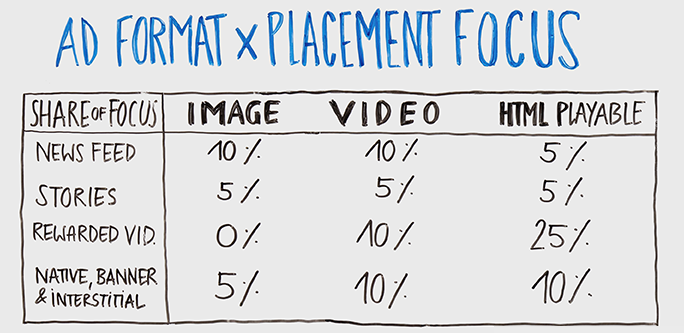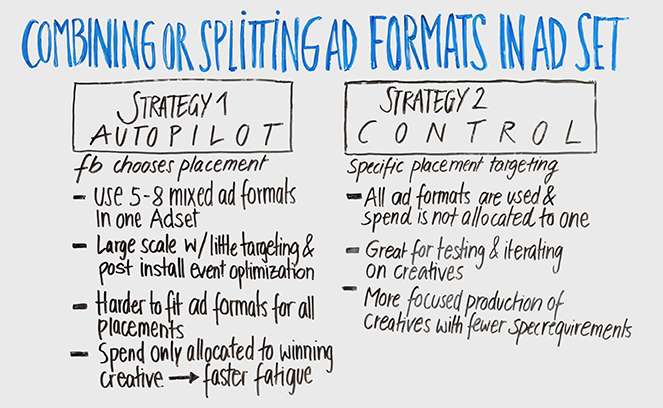
How mobile games can leverage playable ads on Facebook
Welcome to Edition 34 of MAMA Boards, an AppsFlyer video project featuring leading mobile marketing experts on camera.
For today’s mini whiteboard master class, we have Volkmar Reinerth, Marketing Director at Kolibri Games, a mobile game studio aspiring to be the most player-oriented gaming company in the world.
Few verticals are as savvy about ad monetization as Gaming apps, but how do they choose which ad formats and placements to actually serve users? Volkmar steps in with the answers, deep diving into the top 3 formats for Facebook ads and, particularly, how to leverage playable ads for real revenue. Let the games begin!
Real experts, real growth. That’s our motto.
Enjoy!
Transcription
Hi, welcome to MAMA Boards by AppsFlyer. My name is Volkmar, I’m the Marketing Director at Kolibri Games, and I’ve been leading our UA team for three years now. Kolibri Games is a mobile game studio based in Berlin. Our aspiration is to be the most player-oriented games company in the world.
Today, I will be talking about Facebook ad formats, and how to leverage the power of playable ads.
Before I start, please remember that there’s no magic way to master Facebook ads; it will always involve lots of testing and iterating. However, I hope I can give some guidance on which ad formats are worth spending time on, and which ad set strategies can help.
On which combination of Facebook ad formats and placements should I focus?
On your official Facebook ads guide, there are 11 ad formats, and as a fun fact, playables are not even in there. This can either mean that they are not proven to be successful yet, or are still a hidden treasure. Today, I will focus on my main three, which are images, videos, and playables. I think they go hand in hand with the placements; for example, images don’t make sense for rewarded video ads.
So, starting with images, as you all know, they are easy to produce, flexible to use, and can still have a great conversion rate. What I think is great about images is that they can be more detached from the actual game play, and that you can use them for creative testing.
For example, testing a set of images with one character versus another character, and unrelated to the exact winning creative. You can see which concept works better as a whole.
So in summary, I would focus 20% of my time on images, and put a special focus on the Facebook news feed.
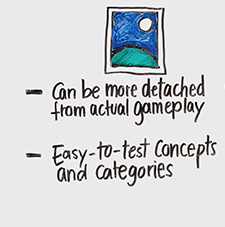
Videos are the next step up. They are a bit more costly to produce, but you can actually keep them simple – a super short, three-second GIF can work equally well as a longer video, and you can work with screen recordings, which is not a lot of work at all. I would start with square videos – they work in almost all placements, and they are very flexible. If you have more resources, then you can move on to tailor placement-specific iterations of your creatives. But I would start with square videos first.
When you make videos, make sure you have a very catchy first second, especially for skippable placements like audience network interstitial or the Facebook news feed. Make sure the first second is very interesting and engaging. If you have a long skippable placement, like Facebook audience network rewarded, you have a bit more time and can work with story-driven ads, or show real game-play.
In summary, I would focus 35% of my time on videos. I think videos are great, make sure you have them in your creative mix, and put a special focus to the audience network rewarded.
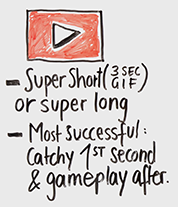
Now moving on to the most interesting ad format of this talk, which are playable ads.
I think playable ads are great, although they are as high-risk as they are high-reward. Realize that they do come with a lot of technical challenges, like bad loading times, crashes, all of which can lead to bad user experience. Make sure you tackle this with good internal QA processes.
Treat every playable like a project all by itself – you often need external resources, which require a lot of communication and is definitely not easy. But in the end, it’s all worth it because, once you actually have the playable ready, players will appreciate that there’s honest gameplay. As in, if they go to the app store, and download from there, they will be more likely to know what your product is about after experiencing the ad. This leads to a good store conversion rate, and also a good day-one retention, because you advertised for actually what your product is about.
Secondly, once you actually have a playable produced, you can tweak little parameters, which can have a huge impact, like the gameplay speed, the background, or the characters. All of this is quite easy to do, and can have a good impact on your conversion rate.

What are some best practices for creating Facebook playable ads for Gaming apps?
When you make playable ads, focus on some do’s.
Firstly, you must include a clickable CTA all the time. Facebook checks for it, make sure you have a button in there all the time.
Secondly, focus on gameplay. It might be challenging to put a lot of complex gameplay into an abstract 20-30 seconds ad, but you can focus, for example, on a core loop, or on certain features of your game. Just make sure it’s real gameplay. Players will appreciate these honest ads, and it will result in a higher conversion rate. Even though clickbait can be a valid strategy, I think gameplay ads are definitely the way to go. So, playables are great, make sure you have them in your mix, don’t miss out on those.
In summary, I would focus most of my time, relatively speaking 45%, on playables, putting a special focus on rewarded video ads. That’s because, with those ads, you have the time, you have 20-30 seconds to actually show what your game is about.
What kind of Facebook ad set strategy should I use?
Moving on to the ad set strategy.
If you look at this table, it looks like there are a lot of placement ad format combinations that you should tackle, but actually, it’s not that much work. You don’t have to look at them individually, you can make use of the Facebook auto-placement feature, which is the first strategy.
Here, I would recommend to use five to eight ads of mixed types; for example, two images, two videos, two playables, putting them all together in one ad set. After that, select the auto-placement option. Facebook will decide to which placement and creative combination the spend goes to, and you don’t have to worry much about it. This can work really well on large-scale campaigns with little targeting, set to post-event optimization. It can also be great for a beginning where you just want to see which placements or creatives work well for you.
It’s hard to fit all the ads for all placements. Like I mentioned before, square videos can work well on most of the placements.
However, if you use playables, for example, it can be more challenging to tailor them to placements like audience network rewarded or interstitials or stories. And, what can happen as well is that spend gets allocated to only one winning creative, or a single winning placement. This in turn means you’re not making full use of your potential here, because only one of the placements is actually used.
In this case, I would recommend to go to the second strategy, which is to take control yourself. Here you would take a specific placement that works well, or that you want to focus on, and split it out into its own ad set, using only placement-specific ads. For example, if you want to focus on Facebook audience network rewarded, you can make full use of rewarded video playables.
This approach is great for testing and iterating on creatives because it’s very focused. You can really see which creatives work well for the specific placement. And since it is a very focused production, you don’t need to worry about too many requirements, yet you still have full control over the budget and other KPIs that you can monitor for your placement.
Both strategies are valid, and have their pros and cons. I think they can also work well together, so it’s not an either-or; you can simultaneously have some ad sets on auto-placement while others are on manual placement. And, they can go hand in hand, just make sure they don’t overlap too much.
What is the future of Facebook ad monetization?
What will the future bring? I think Facebook has a very unique market position. Facebook has massive data and can find users across multiple placements, like discussed in the autopilot strategy. I would expect to see much more features like this in the future, like, for example, Campaign Budget Optimization (CBO).
On one hand, yes, it can mean that you’re losing some control over your campaigns. However, Facebook can make real use of its data, and find users, for example, across multiple placements, or allocate budgets efficiently so there’s not much audience overlap. So, this is a good trend that’s happening in general, because it saves work for you, and it can make the whole advertising ecosystem more efficient from a market perspective.
The second part of my predictions concerns creatives themselves. Right now, it’s about the battle of eyeballs, how to stick out and get attention. Even though clickbait can be a valid strategy, if that works for you, I would still go for a more holistic, and long-term approach, and which I think is gameplay ads. Your audience will appreciate seeing honest gameplay ads, and what your product is actually about, which can lead to a very good user experience, and a good user quality in the end as well.
So I would definitely go for that approach – it’s more long-term, it’s more user-centric – but whatever works for you. However you win the battle of eyeballs, it’s ultimately up to you.
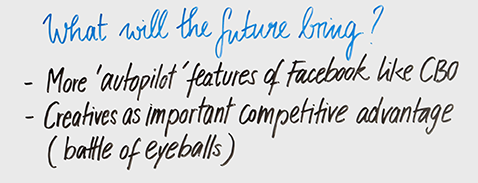
So that’s it for today, If you want to see more MAMA Boards, click here. Thank you for watching. Goodbye.

